Contemporary Management: Theories, Applications, and Recommendations
VerifiedAdded on 2022/10/15
|12
|3618
|13
Report
AI Summary
This report provides a comprehensive overview of contemporary management, examining key theories, applications, and challenges within organizations. It begins with an executive summary and introduction, defining contemporary management and its objectives. The report then delves into the iden...
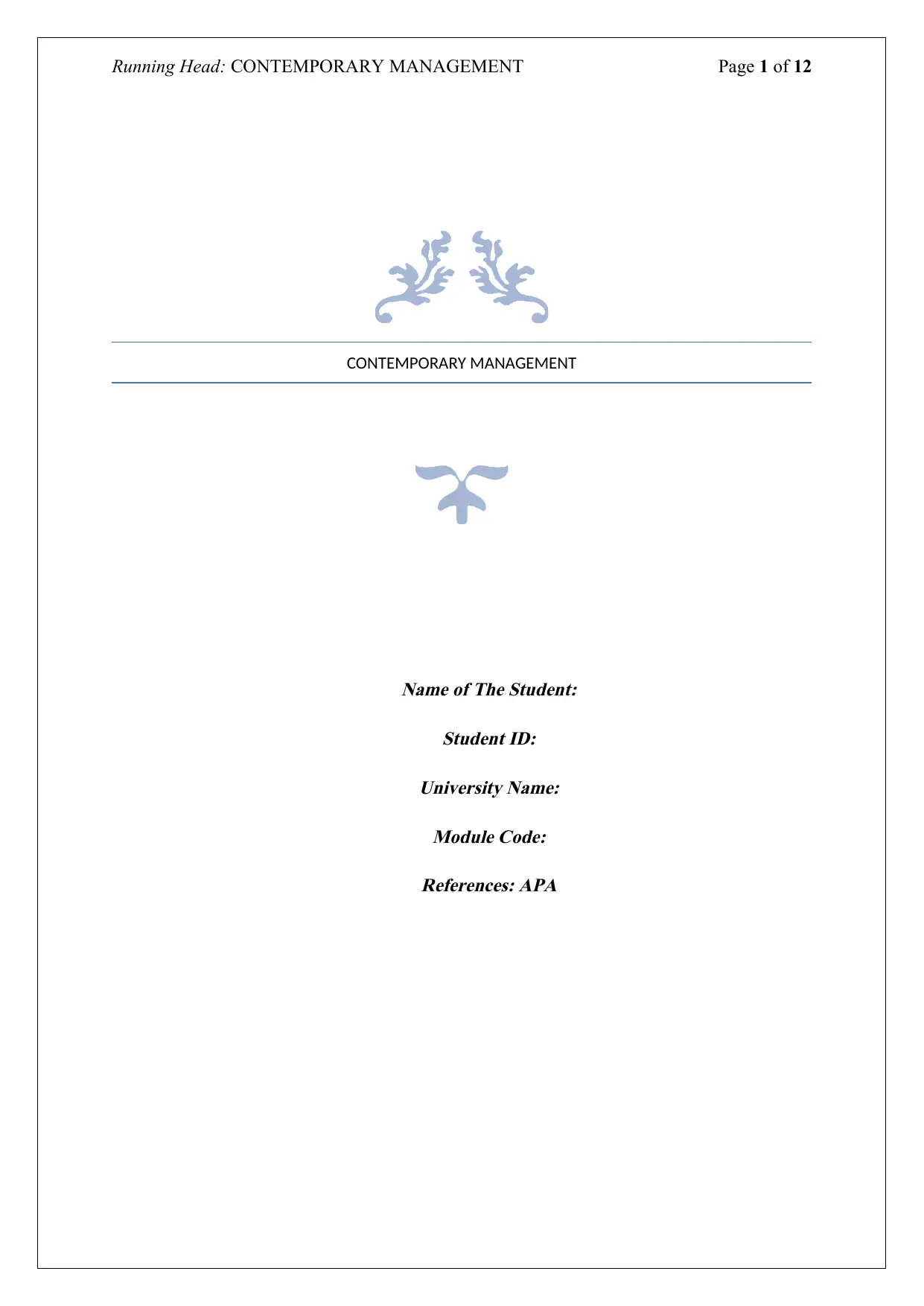
Running Head: CONTEMPORARY MANAGEMENT Page 1 of 12
CONTEMPORARY MANAGEMENT
Name of The Student:
Student ID:
University Name:
Module Code:
References: APA
CONTEMPORARY MANAGEMENT
Name of The Student:
Student ID:
University Name:
Module Code:
References: APA
Paraphrase This Document
Need a fresh take? Get an instant paraphrase of this document with our AI Paraphraser
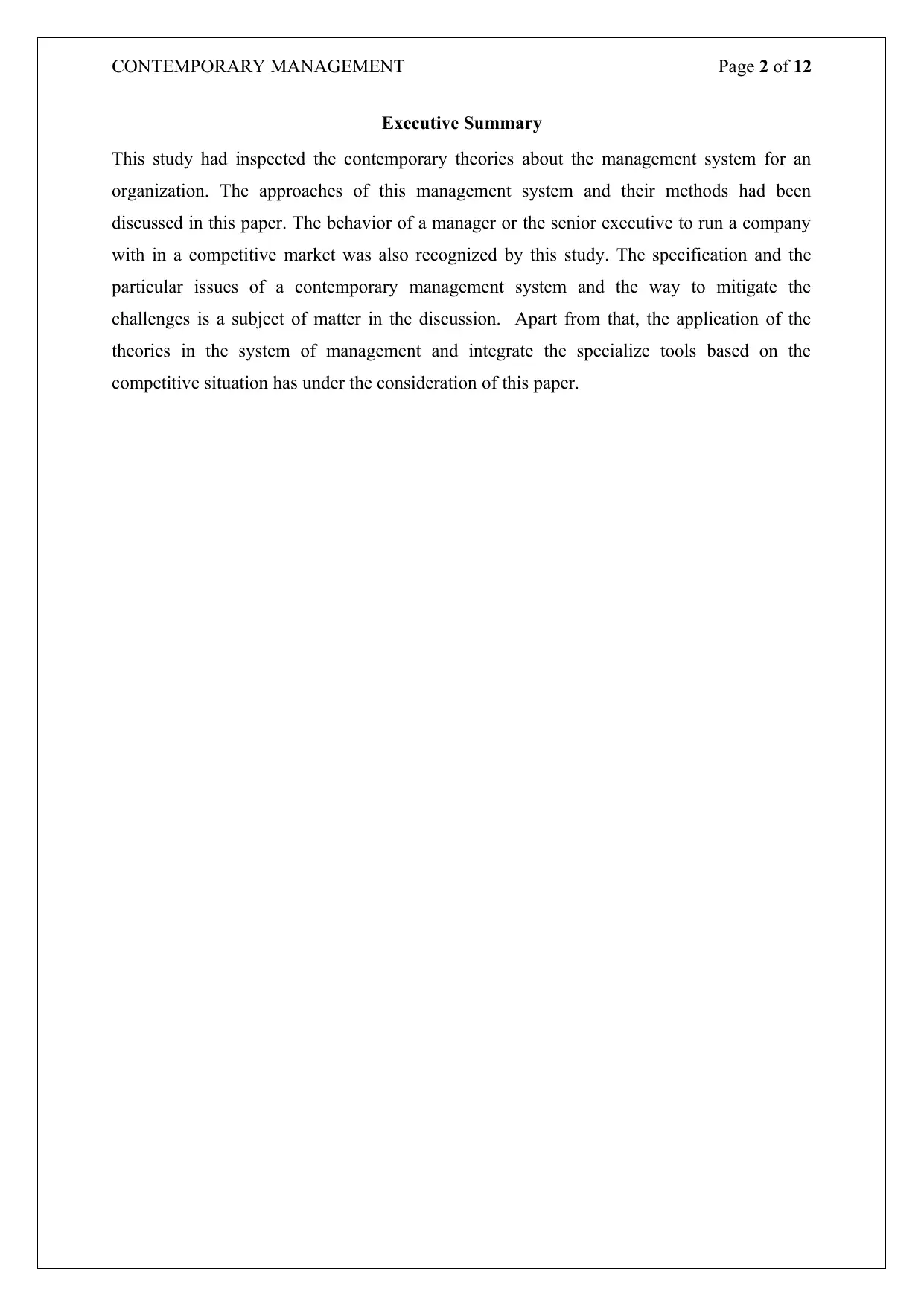
CONTEMPORARY MANAGEMENT Page 2 of 12
Executive Summary
This study had inspected the contemporary theories about the management system for an
organization. The approaches of this management system and their methods had been
discussed in this paper. The behavior of a manager or the senior executive to run a company
with in a competitive market was also recognized by this study. The specification and the
particular issues of a contemporary management system and the way to mitigate the
challenges is a subject of matter in the discussion. Apart from that, the application of the
theories in the system of management and integrate the specialize tools based on the
competitive situation has under the consideration of this paper.
Executive Summary
This study had inspected the contemporary theories about the management system for an
organization. The approaches of this management system and their methods had been
discussed in this paper. The behavior of a manager or the senior executive to run a company
with in a competitive market was also recognized by this study. The specification and the
particular issues of a contemporary management system and the way to mitigate the
challenges is a subject of matter in the discussion. Apart from that, the application of the
theories in the system of management and integrate the specialize tools based on the
competitive situation has under the consideration of this paper.
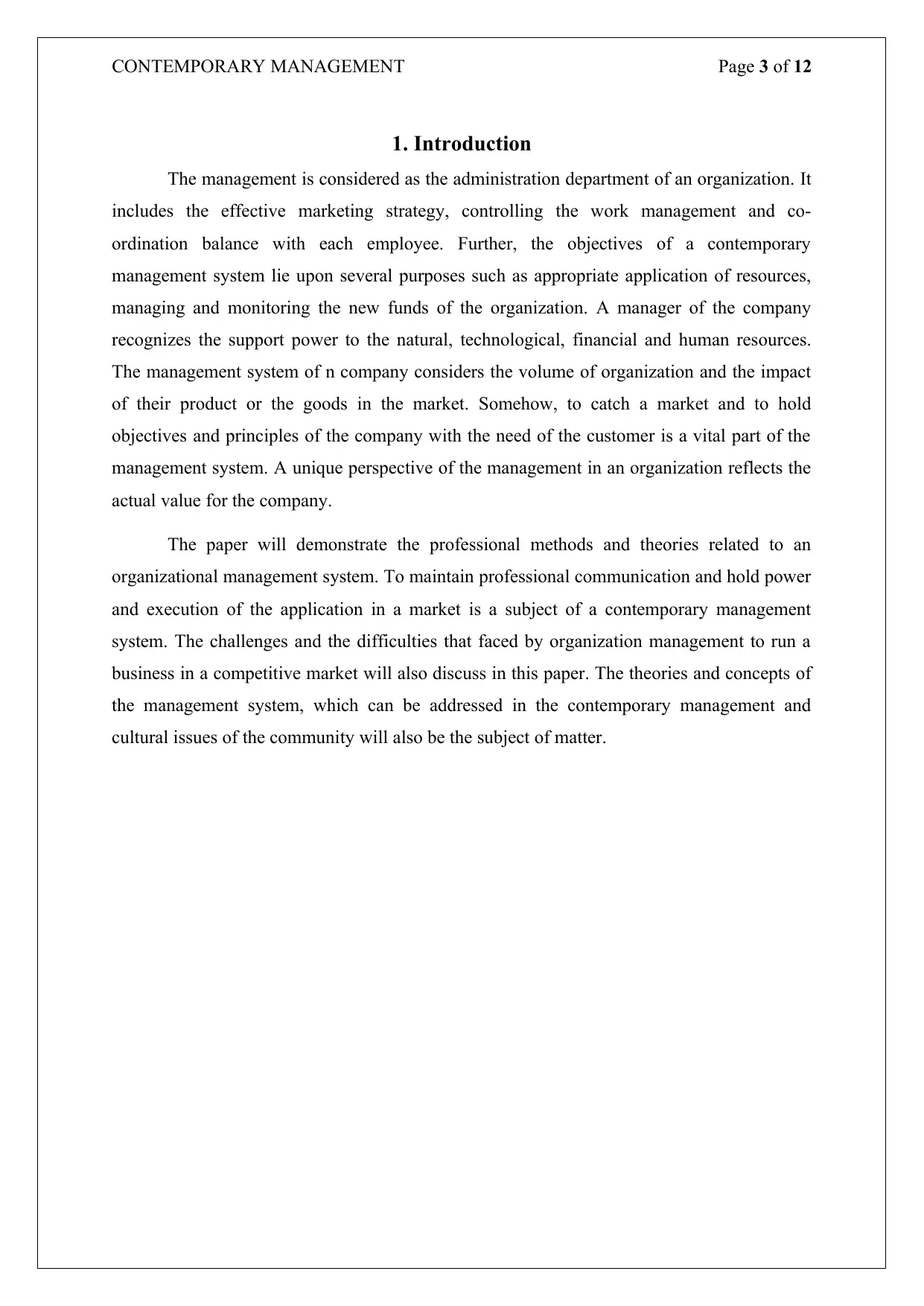
CONTEMPORARY MANAGEMENT Page 3 of 12
1. Introduction
The management is considered as the administration department of an organization. It
includes the effective marketing strategy, controlling the work management and co-
ordination balance with each employee. Further, the objectives of a contemporary
management system lie upon several purposes such as appropriate application of resources,
managing and monitoring the new funds of the organization. A manager of the company
recognizes the support power to the natural, technological, financial and human resources.
The management system of n company considers the volume of organization and the impact
of their product or the goods in the market. Somehow, to catch a market and to hold
objectives and principles of the company with the need of the customer is a vital part of the
management system. A unique perspective of the management in an organization reflects the
actual value for the company.
The paper will demonstrate the professional methods and theories related to an
organizational management system. To maintain professional communication and hold power
and execution of the application in a market is a subject of a contemporary management
system. The challenges and the difficulties that faced by organization management to run a
business in a competitive market will also discuss in this paper. The theories and concepts of
the management system, which can be addressed in the contemporary management and
cultural issues of the community will also be the subject of matter.
1. Introduction
The management is considered as the administration department of an organization. It
includes the effective marketing strategy, controlling the work management and co-
ordination balance with each employee. Further, the objectives of a contemporary
management system lie upon several purposes such as appropriate application of resources,
managing and monitoring the new funds of the organization. A manager of the company
recognizes the support power to the natural, technological, financial and human resources.
The management system of n company considers the volume of organization and the impact
of their product or the goods in the market. Somehow, to catch a market and to hold
objectives and principles of the company with the need of the customer is a vital part of the
management system. A unique perspective of the management in an organization reflects the
actual value for the company.
The paper will demonstrate the professional methods and theories related to an
organizational management system. To maintain professional communication and hold power
and execution of the application in a market is a subject of a contemporary management
system. The challenges and the difficulties that faced by organization management to run a
business in a competitive market will also discuss in this paper. The theories and concepts of
the management system, which can be addressed in the contemporary management and
cultural issues of the community will also be the subject of matter.
You're viewing a preview
Unlock full access by subscribing today!
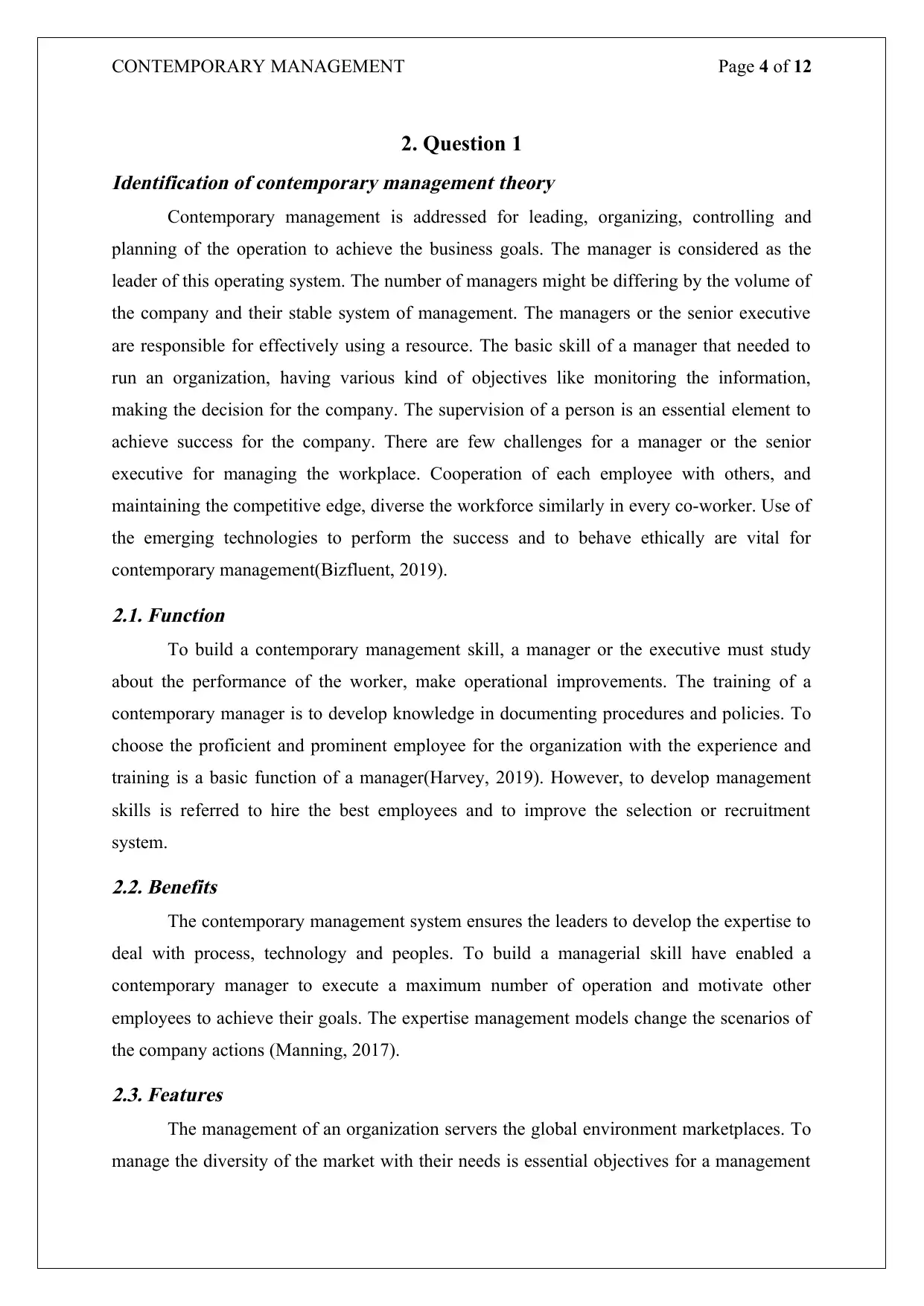
CONTEMPORARY MANAGEMENT Page 4 of 12
2. Question 1Identification of contemporary management theory
Contemporary management is addressed for leading, organizing, controlling and
planning of the operation to achieve the business goals. The manager is considered as the
leader of this operating system. The number of managers might be differing by the volume of
the company and their stable system of management. The managers or the senior executive
are responsible for effectively using a resource. The basic skill of a manager that needed to
run an organization, having various kind of objectives like monitoring the information,
making the decision for the company. The supervision of a person is an essential element to
achieve success for the company. There are few challenges for a manager or the senior
executive for managing the workplace. Cooperation of each employee with others, and
maintaining the competitive edge, diverse the workforce similarly in every co-worker. Use of
the emerging technologies to perform the success and to behave ethically are vital for
contemporary management(Bizfluent, 2019).
2.1. Function
To build a contemporary management skill, a manager or the executive must study
about the performance of the worker, make operational improvements. The training of a
contemporary manager is to develop knowledge in documenting procedures and policies. To
choose the proficient and prominent employee for the organization with the experience and
training is a basic function of a manager(Harvey, 2019). However, to develop management
skills is referred to hire the best employees and to improve the selection or recruitment
system.
2.2. Benefits
The contemporary management system ensures the leaders to develop the expertise to
deal with process, technology and peoples. To build a managerial skill have enabled a
contemporary manager to execute a maximum number of operation and motivate other
employees to achieve their goals. The expertise management models change the scenarios of
the company actions (Manning, 2017).
2.3. Features
The management of an organization servers the global environment marketplaces. To
manage the diversity of the market with their needs is essential objectives for a management
2. Question 1Identification of contemporary management theory
Contemporary management is addressed for leading, organizing, controlling and
planning of the operation to achieve the business goals. The manager is considered as the
leader of this operating system. The number of managers might be differing by the volume of
the company and their stable system of management. The managers or the senior executive
are responsible for effectively using a resource. The basic skill of a manager that needed to
run an organization, having various kind of objectives like monitoring the information,
making the decision for the company. The supervision of a person is an essential element to
achieve success for the company. There are few challenges for a manager or the senior
executive for managing the workplace. Cooperation of each employee with others, and
maintaining the competitive edge, diverse the workforce similarly in every co-worker. Use of
the emerging technologies to perform the success and to behave ethically are vital for
contemporary management(Bizfluent, 2019).
2.1. Function
To build a contemporary management skill, a manager or the executive must study
about the performance of the worker, make operational improvements. The training of a
contemporary manager is to develop knowledge in documenting procedures and policies. To
choose the proficient and prominent employee for the organization with the experience and
training is a basic function of a manager(Harvey, 2019). However, to develop management
skills is referred to hire the best employees and to improve the selection or recruitment
system.
2.2. Benefits
The contemporary management system ensures the leaders to develop the expertise to
deal with process, technology and peoples. To build a managerial skill have enabled a
contemporary manager to execute a maximum number of operation and motivate other
employees to achieve their goals. The expertise management models change the scenarios of
the company actions (Manning, 2017).
2.3. Features
The management of an organization servers the global environment marketplaces. To
manage the diversity of the market with their needs is essential objectives for a management
Paraphrase This Document
Need a fresh take? Get an instant paraphrase of this document with our AI Paraphraser
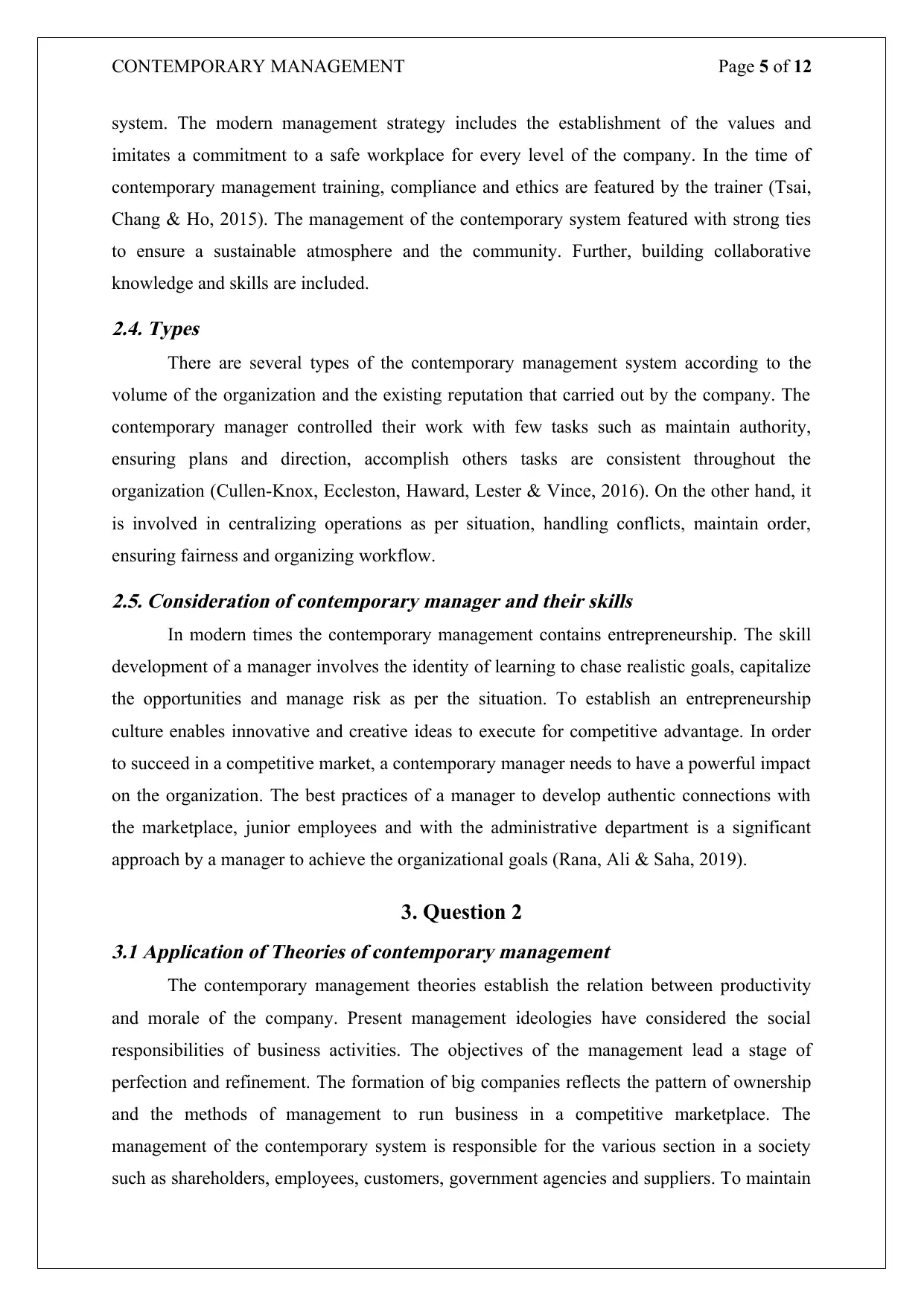
CONTEMPORARY MANAGEMENT Page 5 of 12
system. The modern management strategy includes the establishment of the values and
imitates a commitment to a safe workplace for every level of the company. In the time of
contemporary management training, compliance and ethics are featured by the trainer (Tsai,
Chang & Ho, 2015). The management of the contemporary system featured with strong ties
to ensure a sustainable atmosphere and the community. Further, building collaborative
knowledge and skills are included.
2.4. Types
There are several types of the contemporary management system according to the
volume of the organization and the existing reputation that carried out by the company. The
contemporary manager controlled their work with few tasks such as maintain authority,
ensuring plans and direction, accomplish others tasks are consistent throughout the
organization (Cullen-Knox, Eccleston, Haward, Lester & Vince, 2016). On the other hand, it
is involved in centralizing operations as per situation, handling conflicts, maintain order,
ensuring fairness and organizing workflow.
2.5. Consideration of contemporary manager and their skills
In modern times the contemporary management contains entrepreneurship. The skill
development of a manager involves the identity of learning to chase realistic goals, capitalize
the opportunities and manage risk as per the situation. To establish an entrepreneurship
culture enables innovative and creative ideas to execute for competitive advantage. In order
to succeed in a competitive market, a contemporary manager needs to have a powerful impact
on the organization. The best practices of a manager to develop authentic connections with
the marketplace, junior employees and with the administrative department is a significant
approach by a manager to achieve the organizational goals (Rana, Ali & Saha, 2019).
3. Question 23.1 Application of Theories of contemporary management
The contemporary management theories establish the relation between productivity
and morale of the company. Present management ideologies have considered the social
responsibilities of business activities. The objectives of the management lead a stage of
perfection and refinement. The formation of big companies reflects the pattern of ownership
and the methods of management to run business in a competitive marketplace. The
management of the contemporary system is responsible for the various section in a society
such as shareholders, employees, customers, government agencies and suppliers. To maintain
system. The modern management strategy includes the establishment of the values and
imitates a commitment to a safe workplace for every level of the company. In the time of
contemporary management training, compliance and ethics are featured by the trainer (Tsai,
Chang & Ho, 2015). The management of the contemporary system featured with strong ties
to ensure a sustainable atmosphere and the community. Further, building collaborative
knowledge and skills are included.
2.4. Types
There are several types of the contemporary management system according to the
volume of the organization and the existing reputation that carried out by the company. The
contemporary manager controlled their work with few tasks such as maintain authority,
ensuring plans and direction, accomplish others tasks are consistent throughout the
organization (Cullen-Knox, Eccleston, Haward, Lester & Vince, 2016). On the other hand, it
is involved in centralizing operations as per situation, handling conflicts, maintain order,
ensuring fairness and organizing workflow.
2.5. Consideration of contemporary manager and their skills
In modern times the contemporary management contains entrepreneurship. The skill
development of a manager involves the identity of learning to chase realistic goals, capitalize
the opportunities and manage risk as per the situation. To establish an entrepreneurship
culture enables innovative and creative ideas to execute for competitive advantage. In order
to succeed in a competitive market, a contemporary manager needs to have a powerful impact
on the organization. The best practices of a manager to develop authentic connections with
the marketplace, junior employees and with the administrative department is a significant
approach by a manager to achieve the organizational goals (Rana, Ali & Saha, 2019).
3. Question 23.1 Application of Theories of contemporary management
The contemporary management theories establish the relation between productivity
and morale of the company. Present management ideologies have considered the social
responsibilities of business activities. The objectives of the management lead a stage of
perfection and refinement. The formation of big companies reflects the pattern of ownership
and the methods of management to run business in a competitive marketplace. The
management of the contemporary system is responsible for the various section in a society
such as shareholders, employees, customers, government agencies and suppliers. To maintain
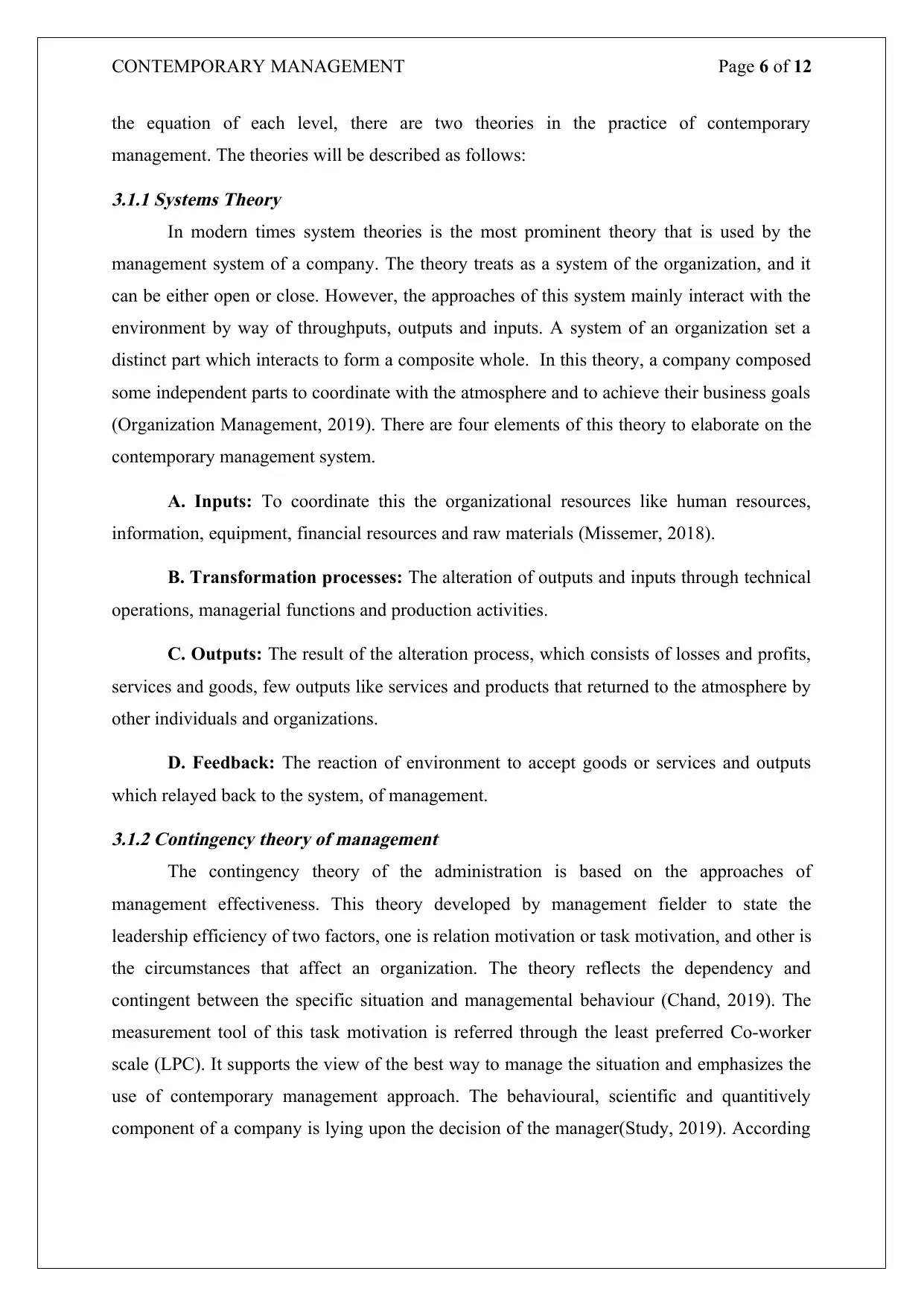
CONTEMPORARY MANAGEMENT Page 6 of 12
the equation of each level, there are two theories in the practice of contemporary
management. The theories will be described as follows:
3.1.1 Systems Theory
In modern times system theories is the most prominent theory that is used by the
management system of a company. The theory treats as a system of the organization, and it
can be either open or close. However, the approaches of this system mainly interact with the
environment by way of throughputs, outputs and inputs. A system of an organization set a
distinct part which interacts to form a composite whole. In this theory, a company composed
some independent parts to coordinate with the atmosphere and to achieve their business goals
(Organization Management, 2019). There are four elements of this theory to elaborate on the
contemporary management system.
A. Inputs: To coordinate this the organizational resources like human resources,
information, equipment, financial resources and raw materials (Missemer, 2018).
B. Transformation processes: The alteration of outputs and inputs through technical
operations, managerial functions and production activities.
C. Outputs: The result of the alteration process, which consists of losses and profits,
services and goods, few outputs like services and products that returned to the atmosphere by
other individuals and organizations.
D. Feedback: The reaction of environment to accept goods or services and outputs
which relayed back to the system, of management.
3.1.2 Contingency theory of management
The contingency theory of the administration is based on the approaches of
management effectiveness. This theory developed by management fielder to state the
leadership efficiency of two factors, one is relation motivation or task motivation, and other is
the circumstances that affect an organization. The theory reflects the dependency and
contingent between the specific situation and managemental behaviour (Chand, 2019). The
measurement tool of this task motivation is referred through the least preferred Co-worker
scale (LPC). It supports the view of the best way to manage the situation and emphasizes the
use of contemporary management approach. The behavioural, scientific and quantitively
component of a company is lying upon the decision of the manager(Study, 2019). According
the equation of each level, there are two theories in the practice of contemporary
management. The theories will be described as follows:
3.1.1 Systems Theory
In modern times system theories is the most prominent theory that is used by the
management system of a company. The theory treats as a system of the organization, and it
can be either open or close. However, the approaches of this system mainly interact with the
environment by way of throughputs, outputs and inputs. A system of an organization set a
distinct part which interacts to form a composite whole. In this theory, a company composed
some independent parts to coordinate with the atmosphere and to achieve their business goals
(Organization Management, 2019). There are four elements of this theory to elaborate on the
contemporary management system.
A. Inputs: To coordinate this the organizational resources like human resources,
information, equipment, financial resources and raw materials (Missemer, 2018).
B. Transformation processes: The alteration of outputs and inputs through technical
operations, managerial functions and production activities.
C. Outputs: The result of the alteration process, which consists of losses and profits,
services and goods, few outputs like services and products that returned to the atmosphere by
other individuals and organizations.
D. Feedback: The reaction of environment to accept goods or services and outputs
which relayed back to the system, of management.
3.1.2 Contingency theory of management
The contingency theory of the administration is based on the approaches of
management effectiveness. This theory developed by management fielder to state the
leadership efficiency of two factors, one is relation motivation or task motivation, and other is
the circumstances that affect an organization. The theory reflects the dependency and
contingent between the specific situation and managemental behaviour (Chand, 2019). The
measurement tool of this task motivation is referred through the least preferred Co-worker
scale (LPC). It supports the view of the best way to manage the situation and emphasizes the
use of contemporary management approach. The behavioural, scientific and quantitively
component of a company is lying upon the decision of the manager(Study, 2019). According
You're viewing a preview
Unlock full access by subscribing today!
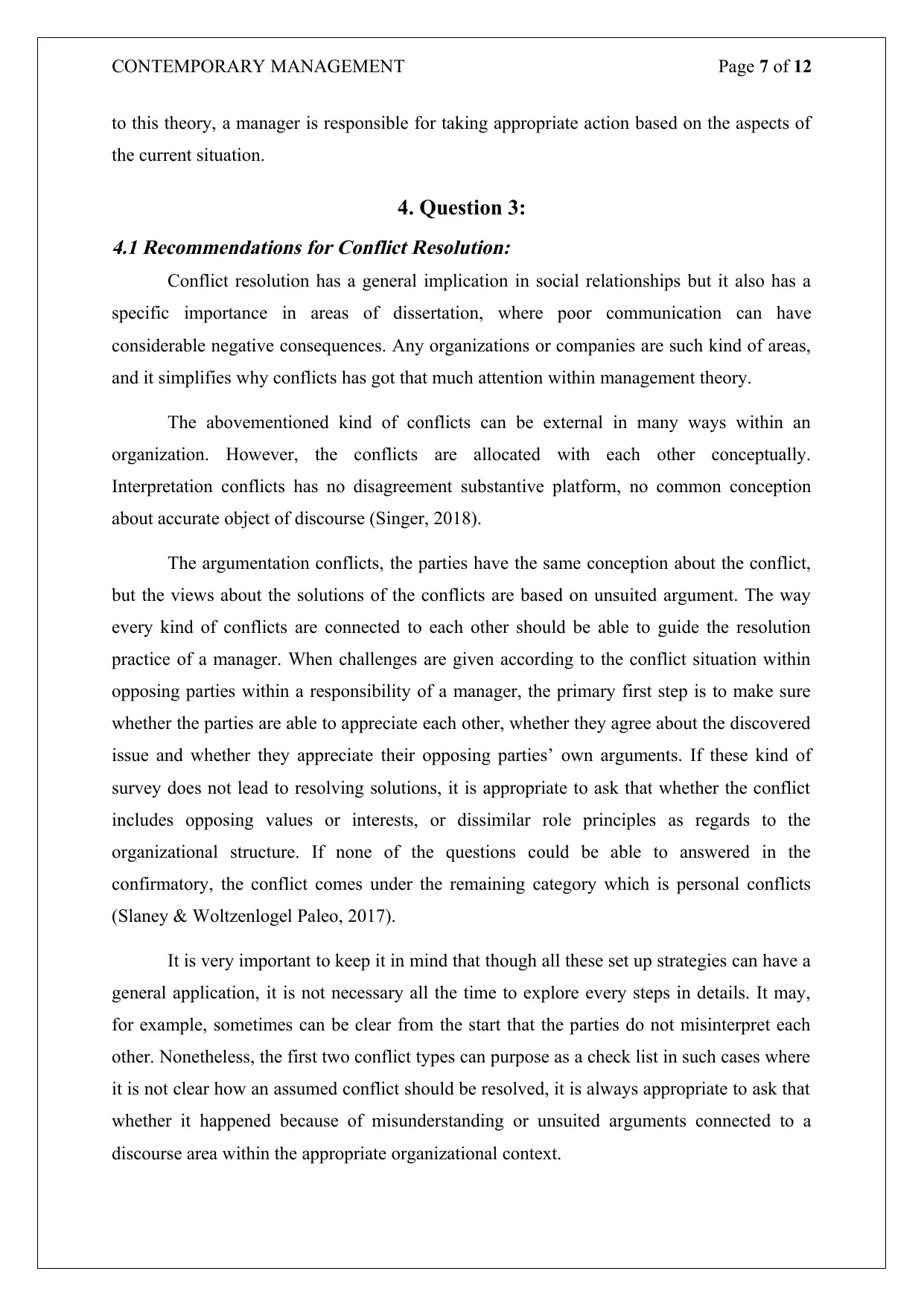
CONTEMPORARY MANAGEMENT Page 7 of 12
to this theory, a manager is responsible for taking appropriate action based on the aspects of
the current situation.
4. Question 3:4.1 Recommendations for Conflict Resolution:
Conflict resolution has a general implication in social relationships but it also has a
specific importance in areas of dissertation, where poor communication can have
considerable negative consequences. Any organizations or companies are such kind of areas,
and it simplifies why conflicts has got that much attention within management theory.
The abovementioned kind of conflicts can be external in many ways within an
organization. However, the conflicts are allocated with each other conceptually.
Interpretation conflicts has no disagreement substantive platform, no common conception
about accurate object of discourse (Singer, 2018).
The argumentation conflicts, the parties have the same conception about the conflict,
but the views about the solutions of the conflicts are based on unsuited argument. The way
every kind of conflicts are connected to each other should be able to guide the resolution
practice of a manager. When challenges are given according to the conflict situation within
opposing parties within a responsibility of a manager, the primary first step is to make sure
whether the parties are able to appreciate each other, whether they agree about the discovered
issue and whether they appreciate their opposing parties’ own arguments. If these kind of
survey does not lead to resolving solutions, it is appropriate to ask that whether the conflict
includes opposing values or interests, or dissimilar role principles as regards to the
organizational structure. If none of the questions could be able to answered in the
confirmatory, the conflict comes under the remaining category which is personal conflicts
(Slaney & Woltzenlogel Paleo, 2017).
It is very important to keep it in mind that though all these set up strategies can have a
general application, it is not necessary all the time to explore every steps in details. It may,
for example, sometimes can be clear from the start that the parties do not misinterpret each
other. Nonetheless, the first two conflict types can purpose as a check list in such cases where
it is not clear how an assumed conflict should be resolved, it is always appropriate to ask that
whether it happened because of misunderstanding or unsuited arguments connected to a
discourse area within the appropriate organizational context.
to this theory, a manager is responsible for taking appropriate action based on the aspects of
the current situation.
4. Question 3:4.1 Recommendations for Conflict Resolution:
Conflict resolution has a general implication in social relationships but it also has a
specific importance in areas of dissertation, where poor communication can have
considerable negative consequences. Any organizations or companies are such kind of areas,
and it simplifies why conflicts has got that much attention within management theory.
The abovementioned kind of conflicts can be external in many ways within an
organization. However, the conflicts are allocated with each other conceptually.
Interpretation conflicts has no disagreement substantive platform, no common conception
about accurate object of discourse (Singer, 2018).
The argumentation conflicts, the parties have the same conception about the conflict,
but the views about the solutions of the conflicts are based on unsuited argument. The way
every kind of conflicts are connected to each other should be able to guide the resolution
practice of a manager. When challenges are given according to the conflict situation within
opposing parties within a responsibility of a manager, the primary first step is to make sure
whether the parties are able to appreciate each other, whether they agree about the discovered
issue and whether they appreciate their opposing parties’ own arguments. If these kind of
survey does not lead to resolving solutions, it is appropriate to ask that whether the conflict
includes opposing values or interests, or dissimilar role principles as regards to the
organizational structure. If none of the questions could be able to answered in the
confirmatory, the conflict comes under the remaining category which is personal conflicts
(Slaney & Woltzenlogel Paleo, 2017).
It is very important to keep it in mind that though all these set up strategies can have a
general application, it is not necessary all the time to explore every steps in details. It may,
for example, sometimes can be clear from the start that the parties do not misinterpret each
other. Nonetheless, the first two conflict types can purpose as a check list in such cases where
it is not clear how an assumed conflict should be resolved, it is always appropriate to ask that
whether it happened because of misunderstanding or unsuited arguments connected to a
discourse area within the appropriate organizational context.
Paraphrase This Document
Need a fresh take? Get an instant paraphrase of this document with our AI Paraphraser
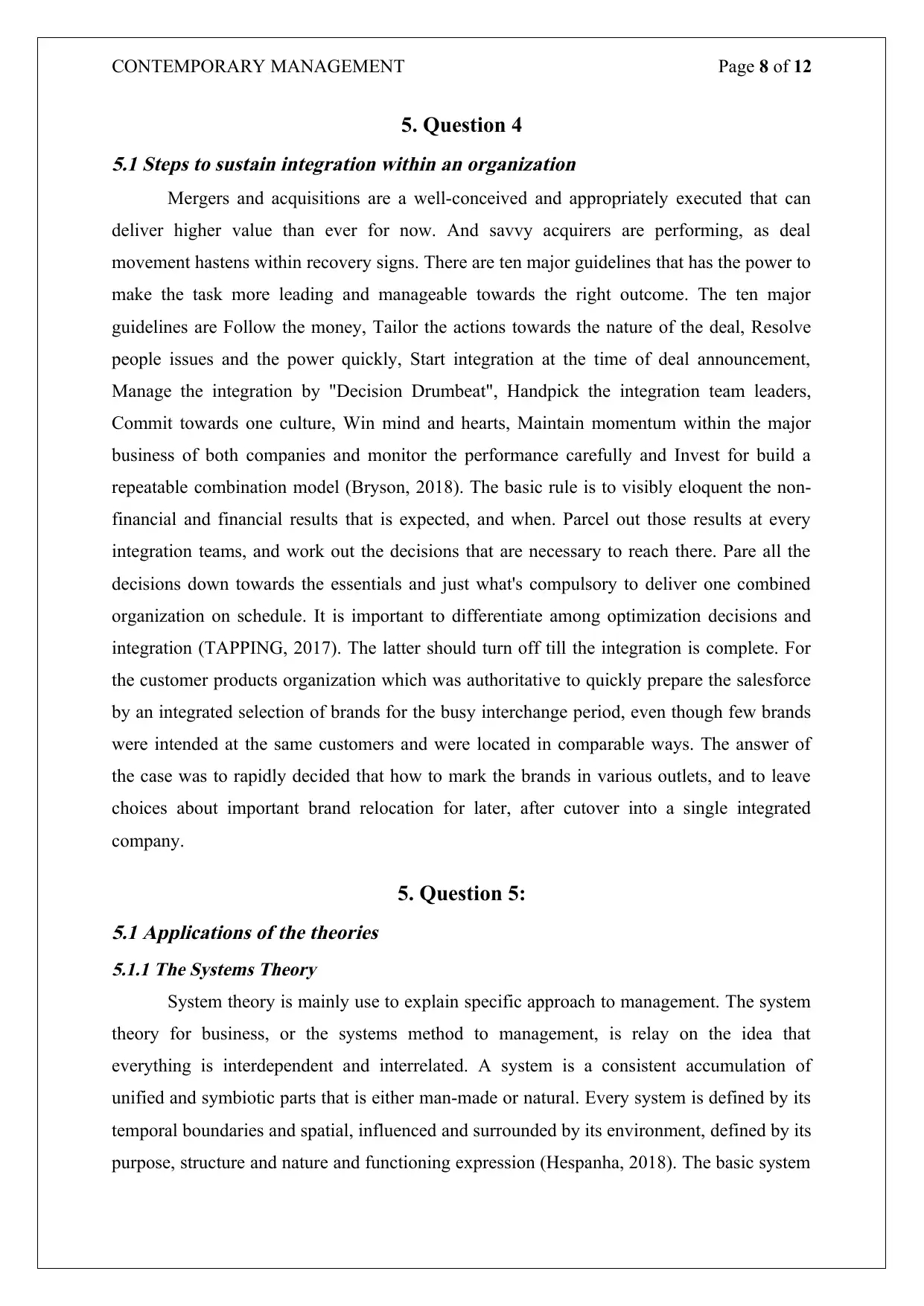
CONTEMPORARY MANAGEMENT Page 8 of 12
5. Question 45.1 Steps to sustain integration within an organization
Mergers and acquisitions are a well-conceived and appropriately executed that can
deliver higher value than ever for now. And savvy acquirers are performing, as deal
movement hastens within recovery signs. There are ten major guidelines that has the power to
make the task more leading and manageable towards the right outcome. The ten major
guidelines are Follow the money, Tailor the actions towards the nature of the deal, Resolve
people issues and the power quickly, Start integration at the time of deal announcement,
Manage the integration by "Decision Drumbeat", Handpick the integration team leaders,
Commit towards one culture, Win mind and hearts, Maintain momentum within the major
business of both companies and monitor the performance carefully and Invest for build a
repeatable combination model (Bryson, 2018). The basic rule is to visibly eloquent the non-
financial and financial results that is expected, and when. Parcel out those results at every
integration teams, and work out the decisions that are necessary to reach there. Pare all the
decisions down towards the essentials and just what's compulsory to deliver one combined
organization on schedule. It is important to differentiate among optimization decisions and
integration (TAPPING, 2017). The latter should turn off till the integration is complete. For
the customer products organization which was authoritative to quickly prepare the salesforce
by an integrated selection of brands for the busy interchange period, even though few brands
were intended at the same customers and were located in comparable ways. The answer of
the case was to rapidly decided that how to mark the brands in various outlets, and to leave
choices about important brand relocation for later, after cutover into a single integrated
company.
5. Question 5:5.1 Applications of the theories
5.1.1 The Systems Theory
System theory is mainly use to explain specific approach to management. The system
theory for business, or the systems method to management, is relay on the idea that
everything is interdependent and interrelated. A system is a consistent accumulation of
unified and symbiotic parts that is either man-made or natural. Every system is defined by its
temporal boundaries and spatial, influenced and surrounded by its environment, defined by its
purpose, structure and nature and functioning expression (Hespanha, 2018). The basic system
5. Question 45.1 Steps to sustain integration within an organization
Mergers and acquisitions are a well-conceived and appropriately executed that can
deliver higher value than ever for now. And savvy acquirers are performing, as deal
movement hastens within recovery signs. There are ten major guidelines that has the power to
make the task more leading and manageable towards the right outcome. The ten major
guidelines are Follow the money, Tailor the actions towards the nature of the deal, Resolve
people issues and the power quickly, Start integration at the time of deal announcement,
Manage the integration by "Decision Drumbeat", Handpick the integration team leaders,
Commit towards one culture, Win mind and hearts, Maintain momentum within the major
business of both companies and monitor the performance carefully and Invest for build a
repeatable combination model (Bryson, 2018). The basic rule is to visibly eloquent the non-
financial and financial results that is expected, and when. Parcel out those results at every
integration teams, and work out the decisions that are necessary to reach there. Pare all the
decisions down towards the essentials and just what's compulsory to deliver one combined
organization on schedule. It is important to differentiate among optimization decisions and
integration (TAPPING, 2017). The latter should turn off till the integration is complete. For
the customer products organization which was authoritative to quickly prepare the salesforce
by an integrated selection of brands for the busy interchange period, even though few brands
were intended at the same customers and were located in comparable ways. The answer of
the case was to rapidly decided that how to mark the brands in various outlets, and to leave
choices about important brand relocation for later, after cutover into a single integrated
company.
5. Question 5:5.1 Applications of the theories
5.1.1 The Systems Theory
System theory is mainly use to explain specific approach to management. The system
theory for business, or the systems method to management, is relay on the idea that
everything is interdependent and interrelated. A system is a consistent accumulation of
unified and symbiotic parts that is either man-made or natural. Every system is defined by its
temporal boundaries and spatial, influenced and surrounded by its environment, defined by its
purpose, structure and nature and functioning expression (Hespanha, 2018). The basic system
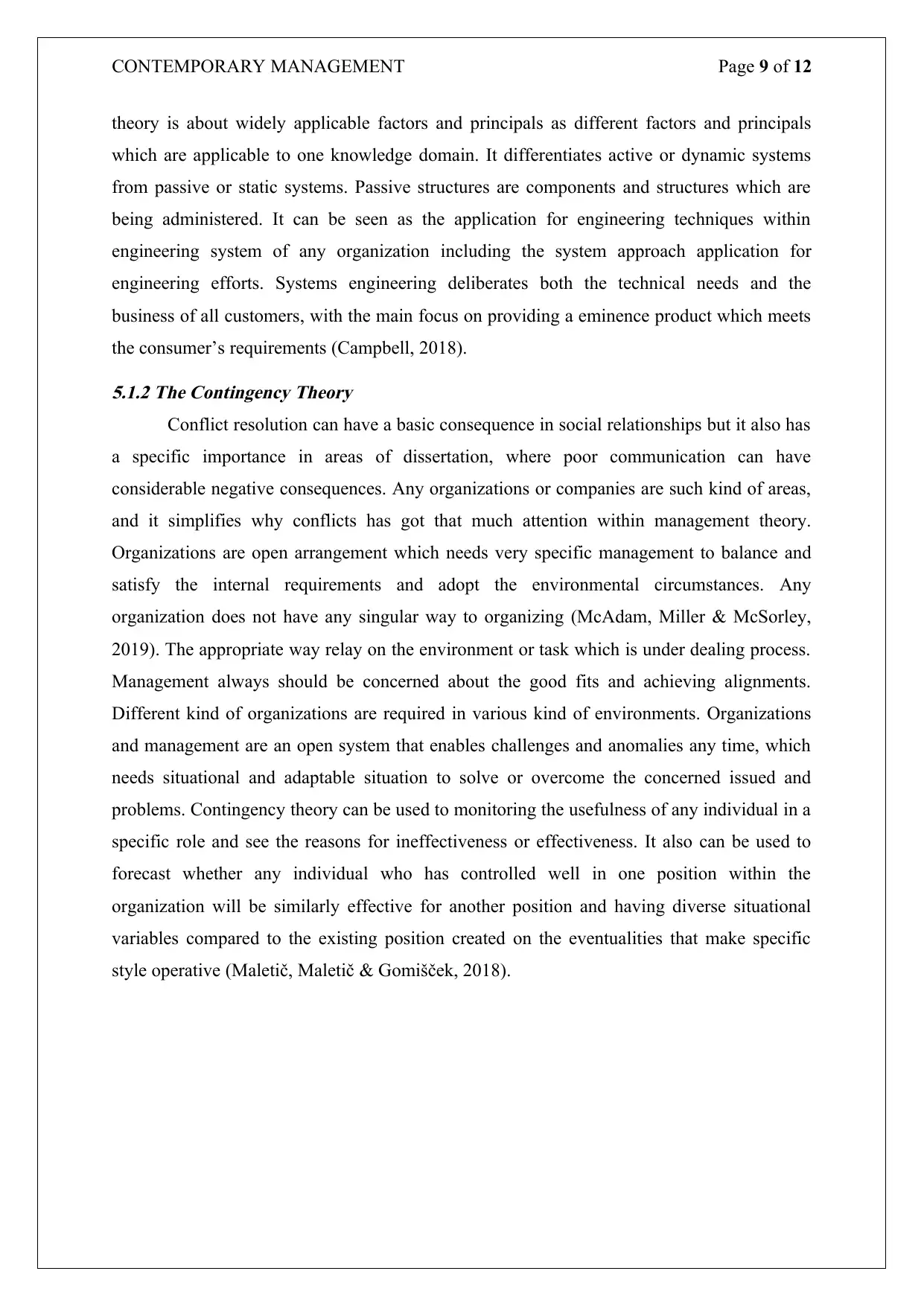
CONTEMPORARY MANAGEMENT Page 9 of 12
theory is about widely applicable factors and principals as different factors and principals
which are applicable to one knowledge domain. It differentiates active or dynamic systems
from passive or static systems. Passive structures are components and structures which are
being administered. It can be seen as the application for engineering techniques within
engineering system of any organization including the system approach application for
engineering efforts. Systems engineering deliberates both the technical needs and the
business of all customers, with the main focus on providing a eminence product which meets
the consumer’s requirements (Campbell, 2018).
5.1.2 The Contingency Theory
Conflict resolution can have a basic consequence in social relationships but it also has
a specific importance in areas of dissertation, where poor communication can have
considerable negative consequences. Any organizations or companies are such kind of areas,
and it simplifies why conflicts has got that much attention within management theory.
Organizations are open arrangement which needs very specific management to balance and
satisfy the internal requirements and adopt the environmental circumstances. Any
organization does not have any singular way to organizing (McAdam, Miller & McSorley,
2019). The appropriate way relay on the environment or task which is under dealing process.
Management always should be concerned about the good fits and achieving alignments.
Different kind of organizations are required in various kind of environments. Organizations
and management are an open system that enables challenges and anomalies any time, which
needs situational and adaptable situation to solve or overcome the concerned issued and
problems. Contingency theory can be used to monitoring the usefulness of any individual in a
specific role and see the reasons for ineffectiveness or effectiveness. It also can be used to
forecast whether any individual who has controlled well in one position within the
organization will be similarly effective for another position and having diverse situational
variables compared to the existing position created on the eventualities that make specific
style operative (Maletič, Maletič & Gomišček, 2018).
theory is about widely applicable factors and principals as different factors and principals
which are applicable to one knowledge domain. It differentiates active or dynamic systems
from passive or static systems. Passive structures are components and structures which are
being administered. It can be seen as the application for engineering techniques within
engineering system of any organization including the system approach application for
engineering efforts. Systems engineering deliberates both the technical needs and the
business of all customers, with the main focus on providing a eminence product which meets
the consumer’s requirements (Campbell, 2018).
5.1.2 The Contingency Theory
Conflict resolution can have a basic consequence in social relationships but it also has
a specific importance in areas of dissertation, where poor communication can have
considerable negative consequences. Any organizations or companies are such kind of areas,
and it simplifies why conflicts has got that much attention within management theory.
Organizations are open arrangement which needs very specific management to balance and
satisfy the internal requirements and adopt the environmental circumstances. Any
organization does not have any singular way to organizing (McAdam, Miller & McSorley,
2019). The appropriate way relay on the environment or task which is under dealing process.
Management always should be concerned about the good fits and achieving alignments.
Different kind of organizations are required in various kind of environments. Organizations
and management are an open system that enables challenges and anomalies any time, which
needs situational and adaptable situation to solve or overcome the concerned issued and
problems. Contingency theory can be used to monitoring the usefulness of any individual in a
specific role and see the reasons for ineffectiveness or effectiveness. It also can be used to
forecast whether any individual who has controlled well in one position within the
organization will be similarly effective for another position and having diverse situational
variables compared to the existing position created on the eventualities that make specific
style operative (Maletič, Maletič & Gomišček, 2018).
You're viewing a preview
Unlock full access by subscribing today!
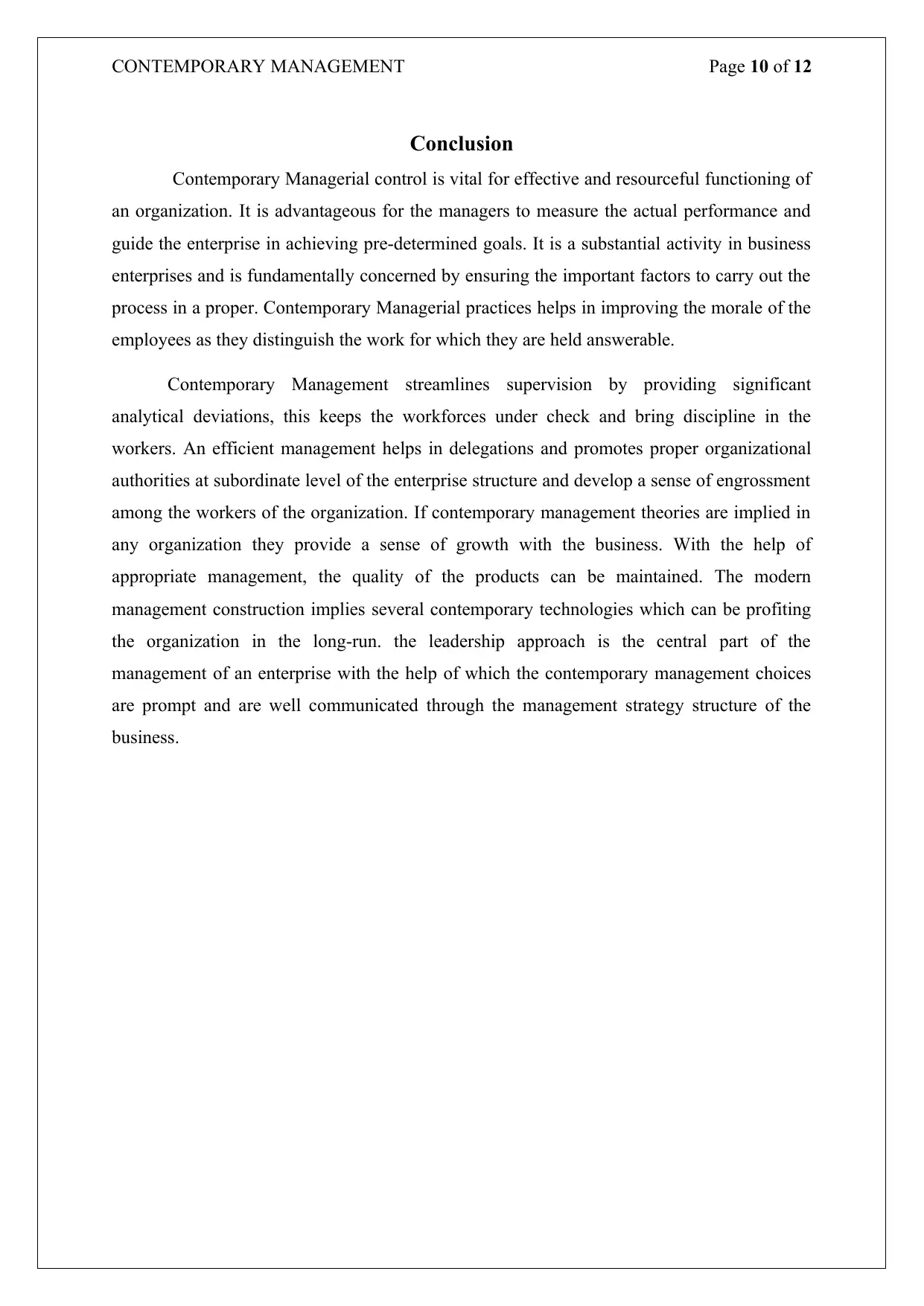
CONTEMPORARY MANAGEMENT Page 10 of 12
Conclusion
Contemporary Managerial control is vital for effective and resourceful functioning of
an organization. It is advantageous for the managers to measure the actual performance and
guide the enterprise in achieving pre-determined goals. It is a substantial activity in business
enterprises and is fundamentally concerned by ensuring the important factors to carry out the
process in a proper. Contemporary Managerial practices helps in improving the morale of the
employees as they distinguish the work for which they are held answerable.
Contemporary Management streamlines supervision by providing significant
analytical deviations, this keeps the workforces under check and bring discipline in the
workers. An efficient management helps in delegations and promotes proper organizational
authorities at subordinate level of the enterprise structure and develop a sense of engrossment
among the workers of the organization. If contemporary management theories are implied in
any organization they provide a sense of growth with the business. With the help of
appropriate management, the quality of the products can be maintained. The modern
management construction implies several contemporary technologies which can be profiting
the organization in the long-run. the leadership approach is the central part of the
management of an enterprise with the help of which the contemporary management choices
are prompt and are well communicated through the management strategy structure of the
business.
Conclusion
Contemporary Managerial control is vital for effective and resourceful functioning of
an organization. It is advantageous for the managers to measure the actual performance and
guide the enterprise in achieving pre-determined goals. It is a substantial activity in business
enterprises and is fundamentally concerned by ensuring the important factors to carry out the
process in a proper. Contemporary Managerial practices helps in improving the morale of the
employees as they distinguish the work for which they are held answerable.
Contemporary Management streamlines supervision by providing significant
analytical deviations, this keeps the workforces under check and bring discipline in the
workers. An efficient management helps in delegations and promotes proper organizational
authorities at subordinate level of the enterprise structure and develop a sense of engrossment
among the workers of the organization. If contemporary management theories are implied in
any organization they provide a sense of growth with the business. With the help of
appropriate management, the quality of the products can be maintained. The modern
management construction implies several contemporary technologies which can be profiting
the organization in the long-run. the leadership approach is the central part of the
management of an enterprise with the help of which the contemporary management choices
are prompt and are well communicated through the management strategy structure of the
business.
Paraphrase This Document
Need a fresh take? Get an instant paraphrase of this document with our AI Paraphraser
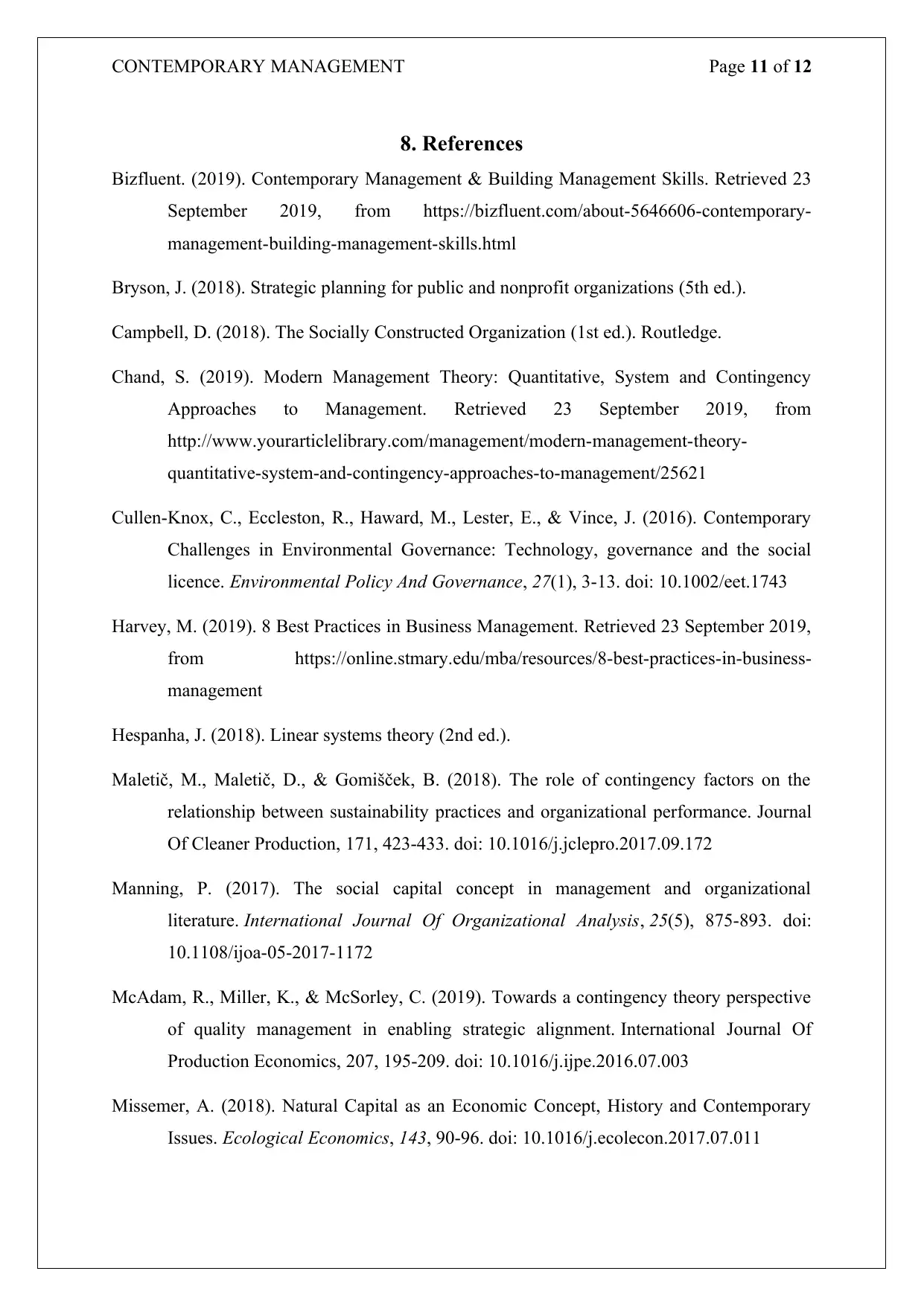
CONTEMPORARY MANAGEMENT Page 11 of 12
8. References
Bizfluent. (2019). Contemporary Management & Building Management Skills. Retrieved 23
September 2019, from https://bizfluent.com/about-5646606-contemporary-
management-building-management-skills.html
Bryson, J. (2018). Strategic planning for public and nonprofit organizations (5th ed.).
Campbell, D. (2018). The Socially Constructed Organization (1st ed.). Routledge.
Chand, S. (2019). Modern Management Theory: Quantitative, System and Contingency
Approaches to Management. Retrieved 23 September 2019, from
http://www.yourarticlelibrary.com/management/modern-management-theory-
quantitative-system-and-contingency-approaches-to-management/25621
Cullen-Knox, C., Eccleston, R., Haward, M., Lester, E., & Vince, J. (2016). Contemporary
Challenges in Environmental Governance: Technology, governance and the social
licence. Environmental Policy And Governance, 27(1), 3-13. doi: 10.1002/eet.1743
Harvey, M. (2019). 8 Best Practices in Business Management. Retrieved 23 September 2019,
from https://online.stmary.edu/mba/resources/8-best-practices-in-business-
management
Hespanha, J. (2018). Linear systems theory (2nd ed.).
Maletič, M., Maletič, D., & Gomišček, B. (2018). The role of contingency factors on the
relationship between sustainability practices and organizational performance. Journal
Of Cleaner Production, 171, 423-433. doi: 10.1016/j.jclepro.2017.09.172
Manning, P. (2017). The social capital concept in management and organizational
literature. International Journal Of Organizational Analysis, 25(5), 875-893. doi:
10.1108/ijoa-05-2017-1172
McAdam, R., Miller, K., & McSorley, C. (2019). Towards a contingency theory perspective
of quality management in enabling strategic alignment. International Journal Of
Production Economics, 207, 195-209. doi: 10.1016/j.ijpe.2016.07.003
Missemer, A. (2018). Natural Capital as an Economic Concept, History and Contemporary
Issues. Ecological Economics, 143, 90-96. doi: 10.1016/j.ecolecon.2017.07.011
8. References
Bizfluent. (2019). Contemporary Management & Building Management Skills. Retrieved 23
September 2019, from https://bizfluent.com/about-5646606-contemporary-
management-building-management-skills.html
Bryson, J. (2018). Strategic planning for public and nonprofit organizations (5th ed.).
Campbell, D. (2018). The Socially Constructed Organization (1st ed.). Routledge.
Chand, S. (2019). Modern Management Theory: Quantitative, System and Contingency
Approaches to Management. Retrieved 23 September 2019, from
http://www.yourarticlelibrary.com/management/modern-management-theory-
quantitative-system-and-contingency-approaches-to-management/25621
Cullen-Knox, C., Eccleston, R., Haward, M., Lester, E., & Vince, J. (2016). Contemporary
Challenges in Environmental Governance: Technology, governance and the social
licence. Environmental Policy And Governance, 27(1), 3-13. doi: 10.1002/eet.1743
Harvey, M. (2019). 8 Best Practices in Business Management. Retrieved 23 September 2019,
from https://online.stmary.edu/mba/resources/8-best-practices-in-business-
management
Hespanha, J. (2018). Linear systems theory (2nd ed.).
Maletič, M., Maletič, D., & Gomišček, B. (2018). The role of contingency factors on the
relationship between sustainability practices and organizational performance. Journal
Of Cleaner Production, 171, 423-433. doi: 10.1016/j.jclepro.2017.09.172
Manning, P. (2017). The social capital concept in management and organizational
literature. International Journal Of Organizational Analysis, 25(5), 875-893. doi:
10.1108/ijoa-05-2017-1172
McAdam, R., Miller, K., & McSorley, C. (2019). Towards a contingency theory perspective
of quality management in enabling strategic alignment. International Journal Of
Production Economics, 207, 195-209. doi: 10.1016/j.ijpe.2016.07.003
Missemer, A. (2018). Natural Capital as an Economic Concept, History and Contemporary
Issues. Ecological Economics, 143, 90-96. doi: 10.1016/j.ecolecon.2017.07.011
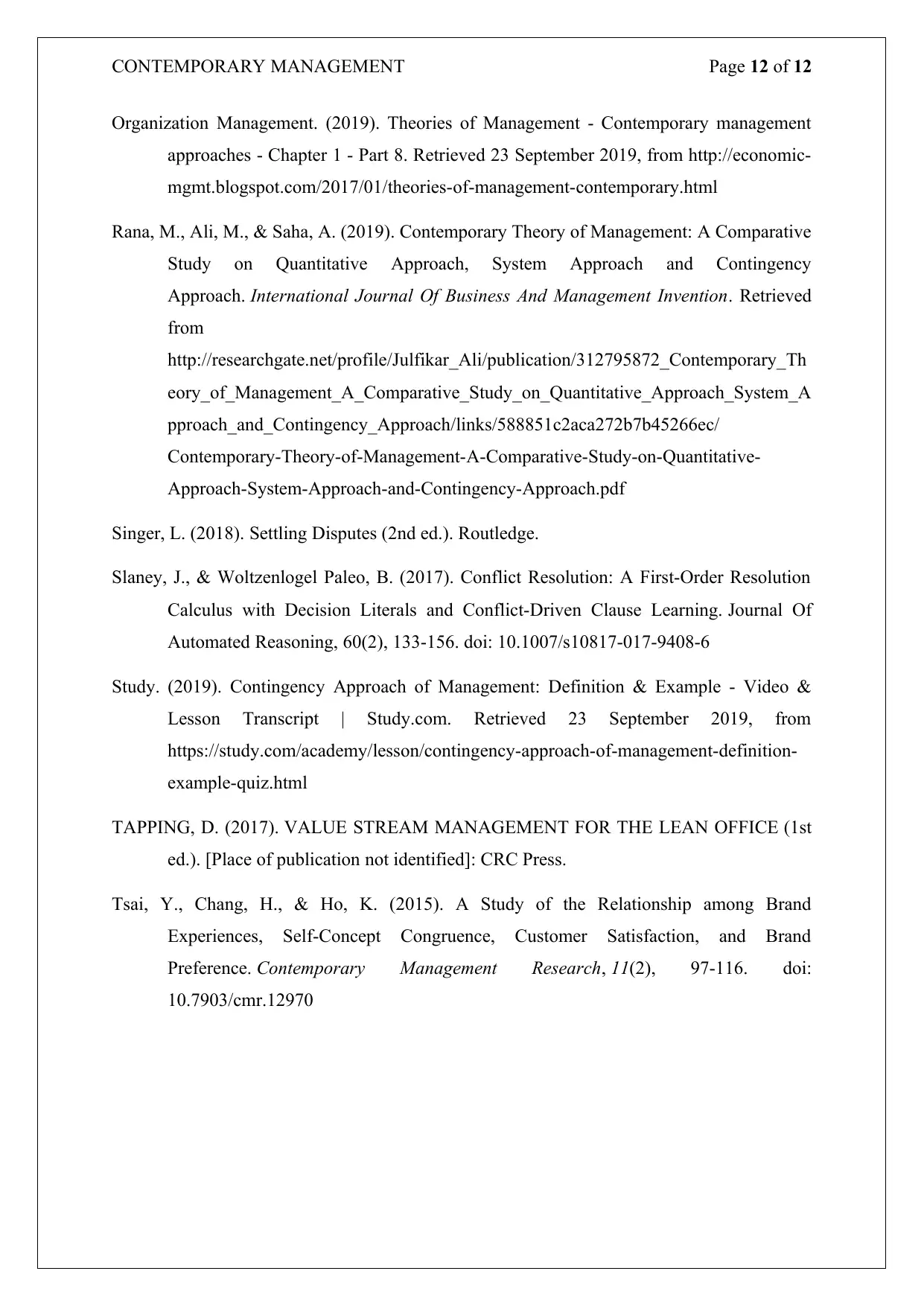
CONTEMPORARY MANAGEMENT Page 12 of 12
Organization Management. (2019). Theories of Management - Contemporary management
approaches - Chapter 1 - Part 8. Retrieved 23 September 2019, from http://economic-
mgmt.blogspot.com/2017/01/theories-of-management-contemporary.html
Rana, M., Ali, M., & Saha, A. (2019). Contemporary Theory of Management: A Comparative
Study on Quantitative Approach, System Approach and Contingency
Approach. International Journal Of Business And Management Invention. Retrieved
from
http://researchgate.net/profile/Julfikar_Ali/publication/312795872_Contemporary_Th
eory_of_Management_A_Comparative_Study_on_Quantitative_Approach_System_A
pproach_and_Contingency_Approach/links/588851c2aca272b7b45266ec/
Contemporary-Theory-of-Management-A-Comparative-Study-on-Quantitative-
Approach-System-Approach-and-Contingency-Approach.pdf
Singer, L. (2018). Settling Disputes (2nd ed.). Routledge.
Slaney, J., & Woltzenlogel Paleo, B. (2017). Conflict Resolution: A First-Order Resolution
Calculus with Decision Literals and Conflict-Driven Clause Learning. Journal Of
Automated Reasoning, 60(2), 133-156. doi: 10.1007/s10817-017-9408-6
Study. (2019). Contingency Approach of Management: Definition & Example - Video &
Lesson Transcript | Study.com. Retrieved 23 September 2019, from
https://study.com/academy/lesson/contingency-approach-of-management-definition-
example-quiz.html
TAPPING, D. (2017). VALUE STREAM MANAGEMENT FOR THE LEAN OFFICE (1st
ed.). [Place of publication not identified]: CRC Press.
Tsai, Y., Chang, H., & Ho, K. (2015). A Study of the Relationship among Brand
Experiences, Self-Concept Congruence, Customer Satisfaction, and Brand
Preference. Contemporary Management Research, 11(2), 97-116. doi:
10.7903/cmr.12970
Organization Management. (2019). Theories of Management - Contemporary management
approaches - Chapter 1 - Part 8. Retrieved 23 September 2019, from http://economic-
mgmt.blogspot.com/2017/01/theories-of-management-contemporary.html
Rana, M., Ali, M., & Saha, A. (2019). Contemporary Theory of Management: A Comparative
Study on Quantitative Approach, System Approach and Contingency
Approach. International Journal Of Business And Management Invention. Retrieved
from
http://researchgate.net/profile/Julfikar_Ali/publication/312795872_Contemporary_Th
eory_of_Management_A_Comparative_Study_on_Quantitative_Approach_System_A
pproach_and_Contingency_Approach/links/588851c2aca272b7b45266ec/
Contemporary-Theory-of-Management-A-Comparative-Study-on-Quantitative-
Approach-System-Approach-and-Contingency-Approach.pdf
Singer, L. (2018). Settling Disputes (2nd ed.). Routledge.
Slaney, J., & Woltzenlogel Paleo, B. (2017). Conflict Resolution: A First-Order Resolution
Calculus with Decision Literals and Conflict-Driven Clause Learning. Journal Of
Automated Reasoning, 60(2), 133-156. doi: 10.1007/s10817-017-9408-6
Study. (2019). Contingency Approach of Management: Definition & Example - Video &
Lesson Transcript | Study.com. Retrieved 23 September 2019, from
https://study.com/academy/lesson/contingency-approach-of-management-definition-
example-quiz.html
TAPPING, D. (2017). VALUE STREAM MANAGEMENT FOR THE LEAN OFFICE (1st
ed.). [Place of publication not identified]: CRC Press.
Tsai, Y., Chang, H., & Ho, K. (2015). A Study of the Relationship among Brand
Experiences, Self-Concept Congruence, Customer Satisfaction, and Brand
Preference. Contemporary Management Research, 11(2), 97-116. doi:
10.7903/cmr.12970
You're viewing a preview
Unlock full access by subscribing today!
1 out of 12
Related Documents
Your All-in-One AI-Powered Toolkit for Academic Success.
+13062052269
info@desklib.com
Available 24*7 on WhatsApp / Email
![[object Object]](/_next/static/media/star-bottom.7253800d.svg)
Unlock your academic potential
© 2024 | Zucol Services PVT LTD | All rights reserved.



